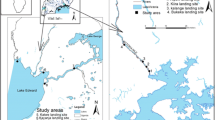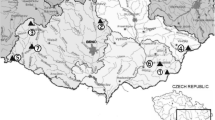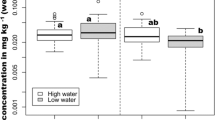Summary
A possible way for contamination of the environment with mercury occurs during cultivation of flowerbulbs when the bulbs have to be disinfected by submerging in a bath with a mercury solution. The disposal of the used mercury solutions has been regulated recently but it can be presumed that before that time amounts of mercury have polluted environmental water. A total of 84 eels was sampled from 2 canals and 5 lakes in an area in Holland where cultivation of flowerbulbs is very important. Each fish was weighed and analysed for mercury content. The results were statistically tested for relationships between weight and mercury content and for the influence of place of capture. Taking all eels together a significant correlation could be established between weight and mercury content and a similar correlation was found for three separate places of capture.
There were also significant differences in mean mercury content between places of capture and it was noted that places farthest removed from the centre of bulbcultivation showed lowest mean mercury contents. So it was concluded that a connection of mercury contamination with bulb cultivation cannot be excluded.
Zusammenfassung
Während der Kultivierung von Blumenzwiebeln werden die Zwiebeln desinfiziert, indem sie in eine Quecksilberlösung untergetaucht werden. Neuerdings hat man die Beseitigung dieser Quecksilberlösungen gesetzlich geregelt, aber es ist wahrscheinlich, daß erhebliche Mengen Quecksilber in verschiedene Kanäle, Gräben und umliegende Seen abgeführt wurden, bevor diese Anordnung in Kraft getreten war.
In Zusammenhang mit diesem Problem wurden aus 2 Kanälen und 5 Seen, gelegen im Blumenzwiebelgebiet, 84 Aale gezogen. Jeder Fisch wurde gewogen und auf den Quecksilbergehalt untersucht. Die Resultate wurden statistisch ausgearbeitet; es konnte im allgemeinen eine signifikante Beziehung ermittelt werden zwischen dem Gewicht des Aales und dem Quecksilbergehalt. Ein solcher Zusammenhang wurde auch für drei der sieben Fischfanggebiete festgestellt.
Es wurden auch signifikante Unterschiede zwischen dem Mittelwert der Quecksilbergehalte der Fischfanggebiete gefunden, d. h. in Gewässern, die am weitesten vom Blumenzwiebelgebiet entfernt lagen, waren die Quecksilbergehalte am niedrigsten.
Similar content being viewed by others
References
Jernelöv,A.: New Scientist, December 1968.
Koeman, J.H., Vink, J.A.J., de Goeij, J.J.M.: Ardea57, 67 (1969).
Johnels, A.G., Olssen, M., Westermark, T.: Bull. off. int. Epin69, 1439 (1968).
Bericht Nr 1831, Plantenziektenkundige Dienst, Wageningen 1972.
Jeffus, M.T., Elkins, J.S.: J. Assoc. Offic. Analyt. Chemist53, 1172 (1970).
Lindstedt, G.: Analyst95, 264 (1970).
Wheeler, A.: The fishes of the British Isles and North West Europe p. 227. London: Mcmillan and Co Ltd 1969.
Renner, E.: Mathematisch-statistische Methoden in der praktischen Anwendung S. 34. Berlin: Verlag Paul Parey 1970.
Author information
Authors and Affiliations
Rights and permissions
About this article
Cite this article
Nuijt, M.F., Van Der Velden, H. The influence of weight and place of capture on the mercury content of some dutch eels. Z Lebensm Unters Forch 151, 89–94 (1973). https://doi.org/10.1007/BF01842917
Received:
Issue Date:
DOI: https://doi.org/10.1007/BF01842917




